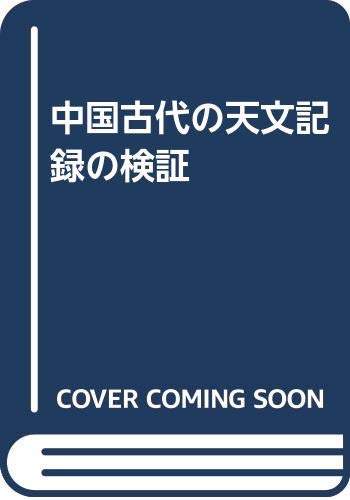23 0 0 0 IR 平勢隆郎氏の歴史研究に見られる五つの致命的欠陥
- 著者
- 小沢 賢二 オザワ ケンジ
- 出版者
- 大阪大学中国学会
- 雑誌
- 中国研究集刊 (ISSN:09162232)
- 巻号頁・発行日
- no.40, pp.1-36, 2006-06
18 0 0 0 平勢隆郎氏の歴史研究に見られる五つの致命的欠陥
- 著者
- 小沢 賢二
- 出版者
- 大阪大学中国学会
- 雑誌
- 中国研究集刊 (ISSN:09162232)
- 巻号頁・発行日
- no.40, pp.1-36, 2006-06
3 0 0 0 中国古代の天文記録の検証
- 著者
- 斉藤国治 小沢賢二著
- 出版者
- 雄山閣出版
- 巻号頁・発行日
- 1992
2 0 0 0 中国古代における宇宙構造論の段階的発展(下)
- 著者
- 小沢 賢二
- 出版者
- 大阪大学中国学会
- 雑誌
- 中国研究集刊 (ISSN:09162232)
- 巻号頁・発行日
- no.47, pp.1-27, 2008-12
2 0 0 0 中国古代における宇宙構造論の段階的発展(上)
- 著者
- 小沢 賢二
- 出版者
- 大阪大学中国学会
- 雑誌
- 中国研究集刊 (ISSN:09162232)
- 巻号頁・発行日
- no.46, pp.1-25, 2008-06
1 0 0 0 OA 春秋時代(B. C. 722〜479)の日食 その他天文記事の再検討
- 著者
- 斉藤 国治 小沢 賢二
- 出版者
- 日本科学史学会
- 雑誌
- 科学史研究 (ISSN:21887535)
- 巻号頁・発行日
- vol.26, no.161, pp.24-36, 1987 (Released:2021-09-22)
Chun-Qiu (春秋) or the Spring and Autumn Annals is a chronicle of Luo (魯), a state of Ancient China, covering the period from 722 bc to 479 bc. It includes astronomical records such as solar eclipses, comets, planetary motions etc.. Among these data, solar eclipses, 37 in total, have been examined by many scholars to make clear the calendar of the period. Conclusion is that 33 among the above-mentioned 37 eclipses can be identified with those listed in Oppolzer's "Canon der Finsternisse", while the remaining four have been abandoned as doubtful because no eclipses can take place on the dates of the records. The present paper shows that two of the hitherto-doubted data (# 15 and # 22 of the Chun-Qiu eclipse numbers) can be turned out to be real eclipses solely by changing the year-numbers in the documents as follows. (1) In case of the # 15 eclipse, the original document says, "On a kui-mao day (癸卯) in the sixth month of the seventeenth year of Lord Xuan (宣公) ,a solar eclipse occurred" Simply change the "seventeenth" to the "seventh" in the document, then this record correspnds to Oppolzer's No. 1445 partial eclipse which was visible as much eclipsed as 0.36 in Qufu (曲阜), capital of Luo, in early morning on May 8, in 602 BC. (2) In case of the # 22 eclipse, the document says, "On the first day and geng-chen (庚辰) day in the tenth month of the 21st year of Lord Xian (襄公) a solar eclipse occurred." This hitherto-doubted record recovers its righteousness only by changing the "21 st" to the "26 th". Then the record is identified with the eclipse of Oppolzer's No. 1588 which was seen in Qufu in the evening of October 23, in 547 BC. At this time the sun set at 17:23 while being eclipsed as much as 0.26. (3) Julian days of these re-located eclipses are kui-mao and geng-chen, the same as in the originals. This cannot be a mere coincidence since probability of coincidence by chance between the sexagesimal dates is as small as 1/60. (4) The discovered misprints of dates may have been originated from any disorder of the bamboo tablets or from mistranscriptions in the later times. Anyway, addition of these two eclipses will be useful in order to study the calendar system of the Chun-Qiu Period.
1 0 0 0 OA 天文史料を使って『史記』の「六国年表」を検証する
- 著者
- 斉藤 国治 小沢 賢二
- 出版者
- 日本科学史学会
- 雑誌
- 科学史研究 (ISSN:21887535)
- 巻号頁・発行日
- vol.25, no.157, pp.1-13, 1986 (Released:2021-04-05)
1 0 0 0 IR 清華簡『尚書』文体考 (清華簡特集)
- 著者
- 小沢 賢二 オザワ ケンジ
- 出版者
- 大阪大学中国学会
- 雑誌
- 中国研究集刊 (ISSN:09162232)
- 巻号頁・発行日
- no.53, pp.291-315, 2011-06
清華簡特集

